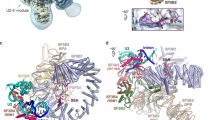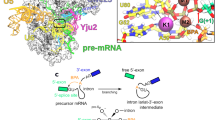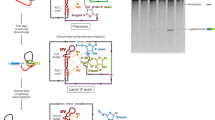Abstract
EXCISION of introns from nuclear precursors to messenger RNAs (pre-mRNAs) by the spliceosome requires two distinct phosphodiester transfer (transesterification) reactions: exchange of a 3′–5′ for a 2′–5′ bond in the first step (lariat formation) and exchange of one 3′–5′ phosphodiester for another in the second step (exon ligation)1–3. We report here determination of the stereochemical course of each step using splicing substrates that contained a chiral phosphorothioate. This has provided strong evidence that both steps occur as single ‘in-line’ SN2 nucleophilic displacement reactions, analogous to the mechanism of group I self-splicing introns4,5. Additionally, because both steps are strongly inhibited by the RP phosphorothioate diastereomer, but not by SP, the spliceosome probably shifts between two active sites in catalysis of the two steps. Chemical and stereochemical similarities suggest that the catalytic site for the second step of spliceosomal processing is related to that of group I self-splicing introns.
This is a preview of subscription content, access via your institution
Access options
Subscribe to this journal
Receive 51 print issues and online access
$199.00 per year
only $3.90 per issue
Buy this article
- Purchase on Springer Link
- Instant access to full article PDF
Prices may be subject to local taxes which are calculated during checkout
Similar content being viewed by others
References
Moore, M. J., Query, C. C. & Sharp, P. A. In The RNA World (eds R. Gesteland & J. Atkins), 303–357 (Cold Spring Harbor Laboratory Press, New York, 1993).
Guthrie, C. Science 253, 157–163 (1991).
Ruby, S. W. & Abelson, J. Trends Genet. 7, 79–85 (1991).
McSwiggen, J. A. & Cech, T. R. Science 244, 679–683 (1989).
Rajagopal, J., Doudna, J. A. & Szostak, J. Science 244, 692–694 (1989).
Knowles, J. R. A. Rev. Biochem. 49, 877–919 (1980).
Eckstein, F. A. Rev. Biochem. 54, 367–402 (1985).
Moore, M. J. & Sharp, P. A. Science 256, 992–997 (1992).
Eckstein, F., Schulz, H. H., Rüterjans, H., Haar, W. & Maurer, W. Biochemistry 11, 3507–3512 (1972).
Burgers, P. M. J. & Eckstein, F. Proc. natn. Acad. Sci. U.S.A. 75, 4798–4800 (1978).
Bryant, F. R. & Benkovic, S. J. Biochemistry 18, 2825–2828 (1979).
Potter, B. V. L., Connolly, B. A. & Eckstein, F. Biochemistry 22, 1369–1377 (1983).
Maschhoff, K. L. & Padgett, R. A. Nucleic Acids Res. 20, 1949–1957 (1992).
Yarus, M. FASEB J. 7, 31–39 (1993).
Steitz, T. A. & Steitz, J. A. Proc. natn. Acad. Sci. U.S.A. 90, 6498–6502 (1993).
Pecoraro, V. L., Hermes, J. D. & Cleland, W. W. Biochemistry 23, 5262–5271 (1984).
Reilly, D. J., Wallace, J. C., Melham, R. F., Kopp, D. W. & Edmonds, M. Meth. Enzym. 180, 177–191 (1989).
Nelson, P. S., Bach, C. T. & Verheyden, J. P. H. J. org. Chem 49, 2314–2317 (1984).
Sharp, P. A. Cell 42, 397–400 (1985).
Cech, T. R. Cell 44, 207–210 (1986).
Cech, T. R. A. Rev. Biochem. 59, 543–568 (1990).
Suh, E.-R. & Waring, R. B. Nucleic Acids Res. 20, 6303–6309 (1992).
Michel, F., Hanna, M., Green, R., Bartel, D. P. & Szostak, J. W. Nature 342, 391–395 (1989).
Been, M. D. & Perrotta, A. R. Science 252, 434–437 (1991).
Herschlag, D., Piccirilli, J. A. & Cech, T. R. Biochemistry 30, 4844–4854 (1991).
Parker, R. & Siliciano, P. G. Nature 361, 660–662 (1993).
Hornig, H., Aebi, M. & Weissmann, C. Nature 324, 589–591 (1986).
Aebi, M., Hornig, H. & Weissmann, C. Cell 50, 237–246 (1987).
Lamond, A. I., Konarska, M. M., Sharp, P. A. Genes Dev. 1, 532–543 (1987).
Frank, D., Patterson, B. & Guthrie, C. Molec. cell. Biol. 12, 5197–5205 (1992).
Mermoud, J. E., Cohen, P. & Lamond, A. I. Nucleic Acids Res. 20, 5263–5269 (1992).
Fabrizio, P. & Abelson, J. Science 250, 404–409 (1990).
McPheeters, D. S. & Abelson, J. Cell 71, 819–831 (1992).
Stec, W. J., Zon, G., Egan, W. & Stec, B. J. Am. chem. Soc. 106, 6077–6079 (1984).
Applied Biosystems Model 380 User Bulletin 44, 1–18 (1987).
Milligan, J. F. & Uhlenbeck, O. C. Meth. Enzym. 180, 51–62 (1989).
Author information
Authors and Affiliations
Rights and permissions
About this article
Cite this article
Moore, M., Sharp, P. Evidence for two active sites in the spliceosome provided by stereochemistry of pre-mRNA splicing. Nature 365, 364–368 (1993). https://doi.org/10.1038/365364a0
Received:
Accepted:
Issue Date:
DOI: https://doi.org/10.1038/365364a0
This article is cited by
-
Genome-wide identification and expression analysis of brassinosteroid action-related genes during the shoot growth of moso bamboo
Molecular Biology Reports (2019)
-
An insight into the evolution of introns in the gyrase A gene of plants
Plant Systematics and Evolution (2018)
-
Human MFAP1 is a cryptic ortholog of the Saccharomyces cerevisiae Spp381 splicing factor
BMC Evolutionary Biology (2017)
-
Evolution of group II introns
Mobile DNA (2015)
-
RNA catalyses nuclear pre-mRNA splicing
Nature (2013)
Comments
By submitting a comment you agree to abide by our Terms and Community Guidelines. If you find something abusive or that does not comply with our terms or guidelines please flag it as inappropriate.



